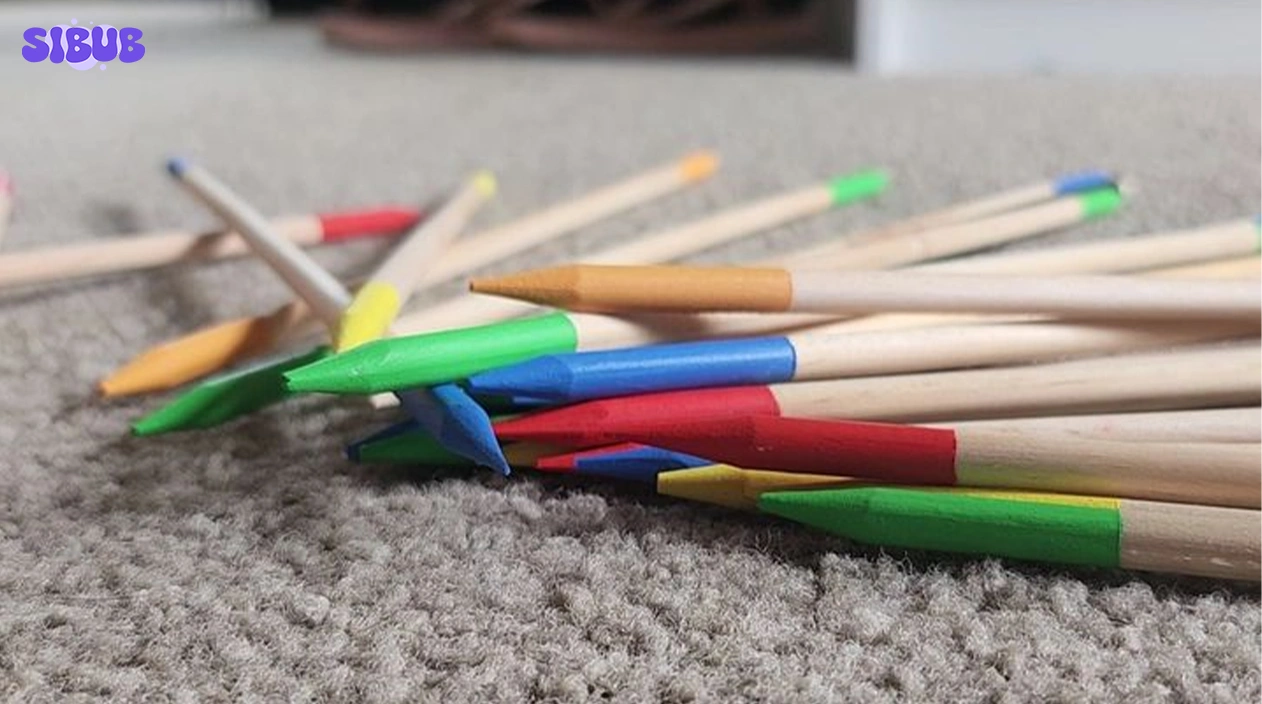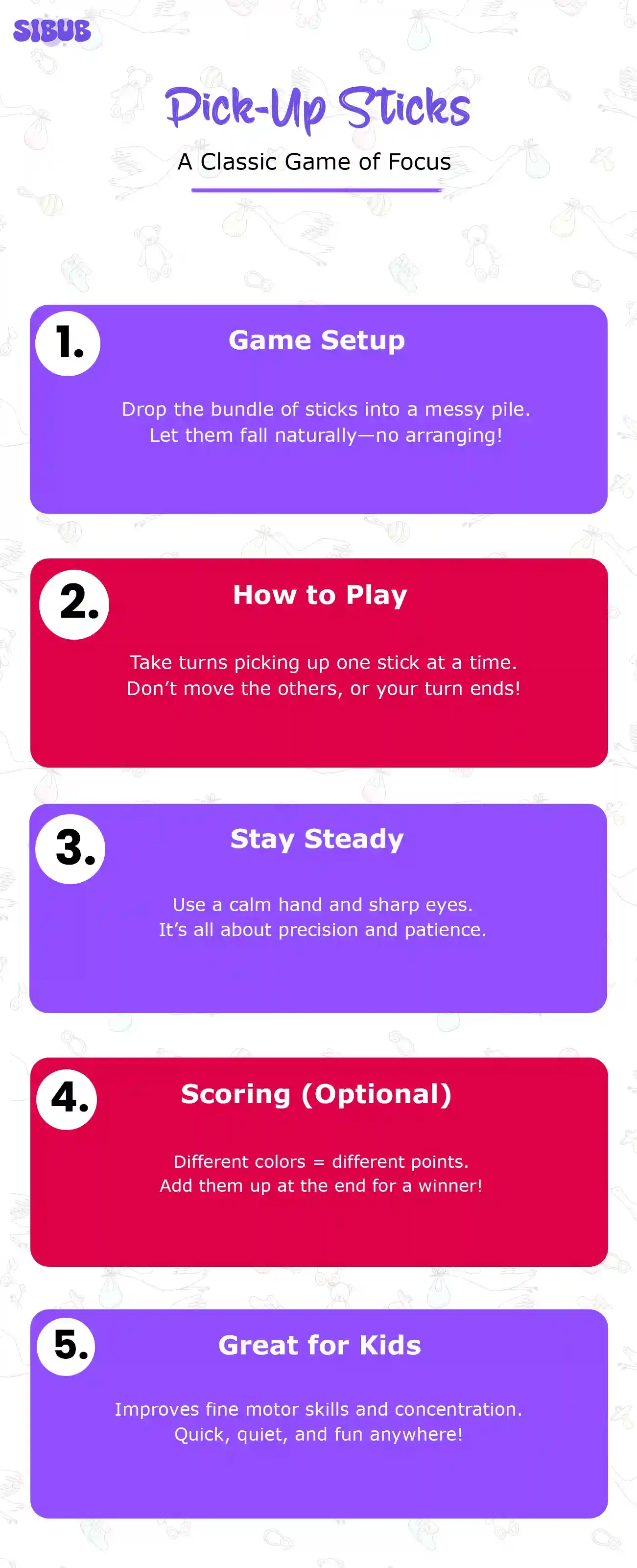Pick Up Sticks has been a simple, fun, and deceptively challenging game enjoyed by people of all ages for multiple centuries. Though it originated around 100 years ago, its straightforward method and a requirement of minimal equipment have made it relevant across generations. Although many modern games are associated with gambling, Pick Up Sticks is a non-wager-based game of dexterity and focus that is rooted deeply in tradition, and it requires skill over luck.
This blog will explore how to play Pick Up Sticks, variations of this game, and why it’s fundamentally not a form of gambling, despite existing within a world where many games involve chance, risk, and reward.
Part 1: Getting Ready to Play Pick Up Sticks
1. Gather Your Equipment
First of all, you’ll need a set of Pick Up Sticks. These sticks can be made up of wood or plastic and could be in various colors. Some modern sets of this game even include a “master stick”, usually black or multicolored, with special notches or features for driving all other sticks.
You’ll also need a flat surface, i.e, a table or maybe the floor, where the sticks can be dropped and played safely.
Keep a paper and a pen in hand, if you want to keep a copy of the scores. Although the scoring is optional, it makes the game more competitive and allows for multiple rounds.

Visit: Infant Sign Language — A Parent’s Guide to Early Communication
2. Get Some Players
As Pick Up Sticks is a multiplayer game, it is ideally played with two or more participants. It is great for kids, families, as well as friends. The simplicity of the rules and the focus on hand-eye coordination make it accessible to almost anyone.
Part 2: Setting Up the Game
1. Write Down the Players’ Names
If you’re scoring, write each player’s name on your score sheet. Leave space to track points earned in each round.
2. Decide on a Goal Score
Agree on a target score for the game; 200, 300, or 500 points are common. Alternatively, you can play until all the sticks have been picked up and simply count who has the highest score or the most sticks.
3. Drop the Sticks
The starting player holds the full bundle of sticks vertically, like a bunch of spaghetti, a few inches above the playing surface. Then they release the bundle, allowing the sticks to fall naturally into a jumbled pile. Once the sticks are at rest, play begins.

Part 3: How to Play Pick Up Sticks
1. Turn Order
The youngest player usually goes first, followed by the player to their left, proceeding in clockwise order.
2. Picking Up Sticks
On your turn, your goal is to remove one stick at a time without moving any other sticks. If you succeed, you may try to pick up another. Your turn continues until you cause any other stick to move, even slightly. If that happens, your turn ends immediately.
Some rule variants limit the number of sticks you can pick up per turn to prolong the game and increase difficulty.
Check this out: Why the First 5 Years Matter – How Early Childhood Shapes Who They Become
3. Scoring System
In some sets, stick colors are used to assign point values. Here are two common scoring variations:
Standard Set Values
- Black (Master Stick) = 25 points
- Red = 10 points
- Blue = 5 points
- Green = 2 points
- Yellow = 1 point
Alternative Set Values
- Red, Blue, Green = 2 points
- Black = 5 points
- Yellow = 7 points
- Multicolored Master Stick = 10 points
At the end of your turn, add the value of the sticks you’ve successfully collected and record it.
Discover: When Do Babies Crawl? Understanding the 7 Stages of Crawling
4. The Master Stick
If a player successfully retrieves the master stick, they gain a unique advantage: they may use it to maneuver or flick other sticks out of the way during future turns, making it easier to pick up more sticks without disturbing the pile.
5. Winning the Game
There are two common ways to end the game:
- Score-Based End: The first player to reach the predetermined goal score wins.
- Stick-Based End: Once all sticks are collected, the player with the highest total score or most sticks wins.
To play another round, simply gather the sticks and repeat the drop.

Pick Up Sticks vs. Gambling
A game world that is saturated with lotteries, poker, sports betting, and casino games involving chance and wagering must be differentiated from the games of pure skill and coordination. Pick Up Sticks is not gambling, and the reasons are:
1. No Wagering or Risk of Value
Gambling is basically staking of something of value, often money, on an uncertain outcome. Pick Up Sticks involves no money, no bets, and no risks beyond the pride of winning or losing. It’s played purely for recreation and competition, not for gain.
2. Outcome Determined by Skill, Not Chance
While many gambling games are driven by randomness (dice rolls, shuffled cards, roulette spins), Pick Up Sticks rewards dexterity, focus, and steady hands. The better your coordination, the better your performance; luck plays almost no role in this game.
This clear emphasis on skill places the Pick Up Sticks with games like chess, checkers, or Jenga, etc. rather than games like slot machines or craps.
Explore: When Do Babies Say Their First Words? A Helpful Parent’s Guide
3. No Commercial House Advantage
Casinos and betting houses profit by occupying the advantageous position or taking a cut of each wager. Pick Up Sticks has no such intermediary, and no mechanism through which an organizer profits at the expense of players. It’s a level playing field.
4. Ethical and Legal Clarity
Because of its non-commercial, non-wagering nature, Pick Up Sticks is universally legal and ethically neutral. It can be played in schools, senior centers, parks, and homes without legal restriction or controversy.
Gambling: A Contrasting World
To better understand why Pick Up Sticks stands apart, it helps to examine the traits of gambling:
- Gambling often involves games such as poker, dice, slot machines, roulette, or sports betting.
- It involves risk and reward, often involving real money.
- Many gambling games combine chance and skill, but some (like lotteries) are almost entirely random.
- The presence of a house edge ensures that the operator profits over time, even if some players win occasionally.
- Some gambling relies on fallacies, such as the idea that past outcomes affect future results (e.g., the Monte Carlo fallacy in roulette).
- Gambling often requires regulation, taxes, and age restrictions due to its potential for addiction and financial harm.
Pick Up Sticks lacks all these qualities. Its reliability, low-stakes nature, and skill-driven gameplay are what make it enduring and safe.
Learn More: 12 Tips to Help Your Child Become Friends with Kids Easily and Confidently
Historical Context
The game of Pick Up Sticks is one of the earliest games, dating back centuries, having been practiced in different cultures. It has possibly hailed from ancient Asian or European games. Traditional versions used natural materials like reed, bone, or carved wood, and were likely used for both recreation and dexterity training.
In contrast, the history of gambling is more problematic. Banned, morally condemned, or criminalized, gambling has undergone vicious scrutiny, particularly from Ancient Egypt to Rome. Pick Up Sticks, powered by secular and wholesome principles, has always been, in essence, the antithesis of gambling, which often centered around superstitious beliefs, fate, or divination.
Ultimately, A Game of Joy, Not a Gamble
Pick Up Sticks requires virtually no prerequisite equipment besides a set of sticks and a level surface, turning it into a fun activity, unlike gambling, which is focused on monetary gain. Moreover, there are no bets to be placed, and focus is the only gambling needed.
The game can assist players of all ages in understanding how to stay calm as well as how to control their hands. This game also help in remembering and recalling good memories and times spent with grandparents, or maybe the rainy days spent indoors playing this enjoyable game.
There’s no barrier to entry in this game, as it’s accessible to everyone. You also don’t need a designated gambling zone, as playing can be done anywhere: a picnic, a classroom, or even a set table.
